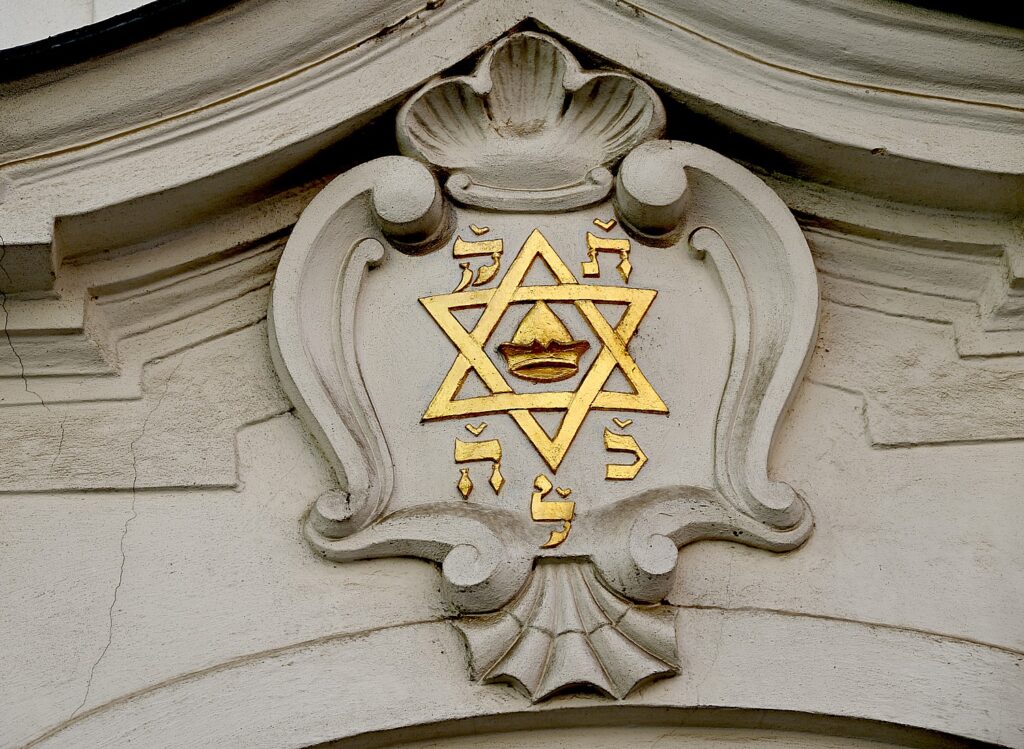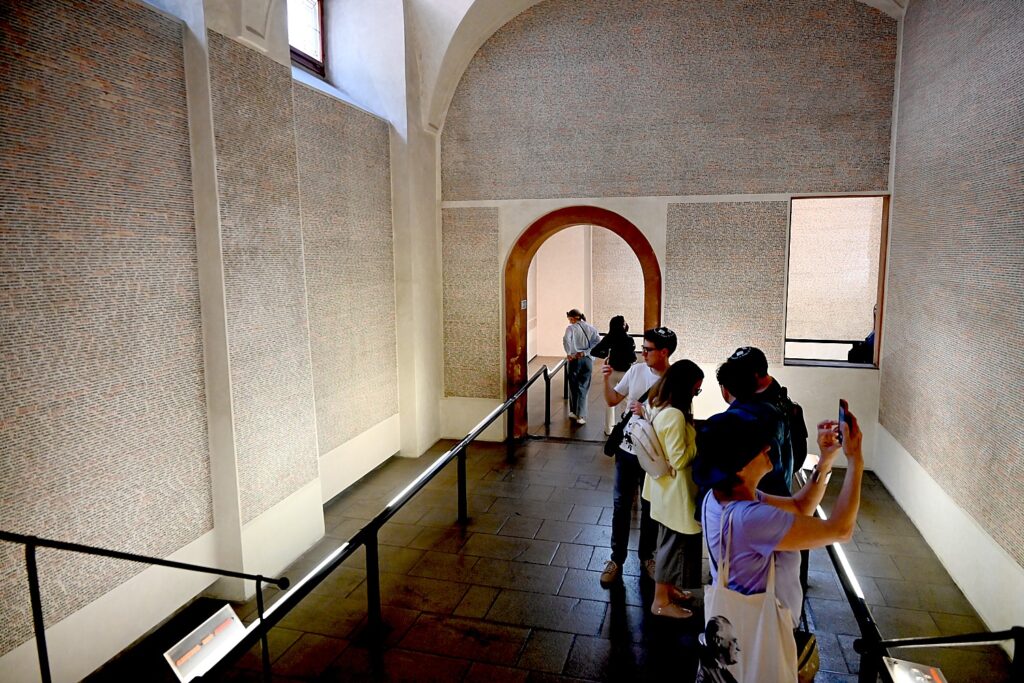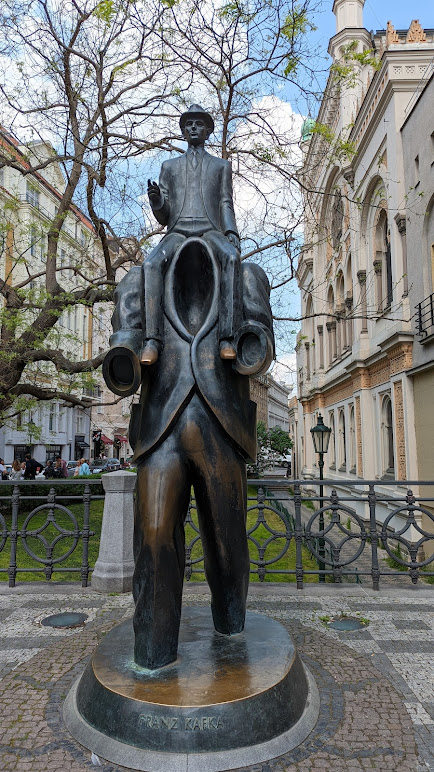
By Karen Rubin, Travel Features Syndicate, goingplacesfarandnear.com
I was so glad I had the cleverness to arrange three full days to explore Prague on my own before embarking on CroisiEurope’s Prague-Berlin river cruise aboard the Elbe Princesse. I could wander, linger, get lost amid the narrow cobblestone streets, be surprised and delighted upon coming upon stunning views of the Prague Castle from the Charles Bridge across the Vltava, the Old Town Square, the Astronomical Clock at night (the most underwhelming scene you can’t miss), contemplate the Lennon Wall, discover the personalities who occupied the tiny houses on Golden Lane in the wall of Prague Castle, follow whimsy and pop into the Lobkowicz Palace to be dazzled, and have the time to really muse over the exhibits, displays and notes in the Jewish Quarter and Prague Castle, and for good measure, visit the National Museum.

And the Prague Cool Pass, which provides free access to over 70 attractions, tours, river cruises, plus discounts to concerts, entertainment and activities, helped maximize my enjoyment and how much I could see and experience in this all too brief time in such a phenomenal destination (praguecoolpass.com).

I lose the better part of a full day when my Delta flight from JFK to Amsterdam was delayed, causing me to miss my connection to Prague (I knew the 50 minute-connection was too good to work out). But if you have to wait eight hours in an airport, Schiphol is one of the most pleasant. Still, instead of arriving at 8 am, I arrive at 5:30 pm, but still in a good mood – largely because I had made a fantastic choice of hotel, the EA ApartHotel Melantrich, which I found on hotels.com, and pre-arranged an airport pick-up through the hotel.

I actually have an entire apartment on a street that strikes me as comparable to New York’s Fifth Avenue – actually Welcelas Square – with the National Museum at one end, and Old Town at the other, walking distance to everything I want to see in my all-too-short time. (Further benefits: the hotel has a gorgeous dining room where an enormous smorgasbord breakfast is served, an outdoor landscaped sitting area, an indoor pool, elevator, bar/lounge.) (EA ApartHotel Melantrich, Praha 1-Vaclavska Namesti 36 Stare Mes Prague, phone +420734596570).
I had used my time in the airport wisely, looking over “Top Attractions in Prague” and “Three Days in Prague” and there was consistency in the must-see list. I only needed to plot out the logistics (only a little tricky because the map (I LOVE a paper map) is in Czech (it takes me a day to figure it out – but I soon figure out that there are also helpful signposts pointing the direction and distance to what most people are looking for). Still, each time I set out, I get a little lost, or rather find a different way, and each time I am surprised and delighted at what I stumble upon.

I drop my bags at the hotel and the concierge points me in the right direction to walk to the Charles Bridge, which has to be the absolute best place to be at sunset. I get there just as the final patches of orange and pink break through clouds. (It turns out was the best of all three nights, proving my maxim to seize every moment) and I get caught up in that whole vibe. There is music, hawkers, a constant flow of people.

I walk back to Old Town Square and come upon the Astronomical Clock (on the hour, there is a 45-second display – the most underwhelming must-see attraction anywhere, but nonetheless, hundreds wait each hour for the show). The square is absolutely stunning. I find my way back to hotel.
The next day, I set out for the Jewish Quarter, stopping again at the Old Town Square and the Astronomical Clock (you can’t resist). I present my Prague Cool Pass at the Jewish Museum – actually seven separate sites that each tell a different part of the story of the Jewish experience in Prague, going back to the 13th century. I kind of do the sites in reverse order, which I actually appreciate more.

I start at the Old-New Synagogue, the oldest landmark of “Jewish Town” in Prague and one of the oldest surviving synagogues in Europe. It has served for more than 700 years as the main synagogue of the Prague’s Jewish community. Why “old new”? Because it wasn’t the oldest or first synagogue – that one was a shul on the site where the Spanish Synagogue, built in 1867, now sits. You go in and see the traditional way the synagogue was laid out – with a bima in center and seats all around the walls (women on other side of the wall). Each of the chairs still has the name plate of the family that has inherited it; one of the chairs has the name of former US Ambassador Norman Eisen, whose family came from here, and the Israeli Ambassador. A banner that hangs high is adorned with a Star of David with a golden hat in the center – the hat was original required for Jewish men to wear, but instead of a humiliation, the Jews made it a badge of identity, so incorporated it into the symbol of the Jewish Quarter.

I go next to the Ceremonial Hall, adjacent to the Jewish Cemetery, which discusses and describes Jewish burial rituals as well as medical care. Next to the Klausen Synagogue, where the exhibits describe Jewish life – you get the sense that the Prague Jews were actually well off, especially compared to the images you typically see of impoverished Jews in the Russian shetls – and you learn that under Joseph II, who reigned from 1780-90, laws governing Jews were liberalized.

Then on to the Pinkus Synagogue, which dates from 1530, where I was surprised to find it has become a memorial to the Shoah. Some 80,000 names of Jews killed just from this region of Bohemia and Moravia are inscribed all over the walls (you can do a search for names on a computer). A gallery in one room displays paintings by Jewish children who had been deported to Terezin, organized by different themes: longing for home, a dream of Palestine, being taken away, memories of family, with the names of the child and the dates of their birth and too soon death.

Their teacher was Friedle Dicker-Brandeis (born in 1898 in Vienna, died 1944 in Auschwitz), who, from the beginning of her internment in Terezin, devoted herself to drawing lessons for the children in the ghetto. Children signed their drawings and wrote their room number, the group to which they belonged, and lesson hour. Then she classified them. She scoured the camp for paper and paint. When she was deported from Terezin to Auschwitz in a “liquidation” transport, she left behind two suitcases with more than 4000 children’s drawings. This display is heart wrenching.
Outside the synagogue, there is a photo exhibit, “Journeys With No Return,” documenting the Nazi removal.

Then you go through a courtyard to enter the Jewish cemetery. There are some 12,000 tombstones in a tumult – crowded together, pushed over in all directions over time and flooding – but actually some 100,000 are buried here. But after going through the Holocaust Memorial, I felt these people at least had a grave, they had people who buried them, said prayers over them, placed stones to show they had come to pay respects.

Having had this tour, I now go to the Maisel Synagogue (marked as the #1 site) which is a museum that describes the history of Jews in the Bohemian lands from the 10th to 18th centuries, and for me, provides a context for what I had been seeing.
Notably, during the reign of Joseph II (1780-90), Jews could attend university and higher education, but their schools were taught in German instead of Hebrew; under special conditions they were allowed to rent land, learn trades and set up factories, and no longer had to wear “identifying marks.” On the other hand, Jews were compelled to adopt fixed first names and surnames (1787), and only the eldest son was allowed to marry; also the Jewish judiciary was abolished (1784) and Jews now had compulsory military service (1788). It is interesting that the Jewish Quarter is named for Joseph II.

In one of the displays, having to do with the effort to assimilate, integrate and convert Jews, I see an etching of the statue of Jesus that is on the Charles Bridge, which I had noted because of the Hebrew lettering, and in Latin, the word for blasphemy. The notes state that “in 1696, the Hebrew inscription ‘Kadosh, Kadosh, Kadosh’ (holy, holy holy) on the statue was paid for by a fine imposed on the Jews Elias Backoffen and Berl Tabor for alleged blasphemy against the cross in a coded letter. The letter in question, however, was never deciphered by the authorities.”
(I wondered how these structures, these monuments and artifacts survived the Holocaust. I read somewhere that Hitler loved Prague and had thought to “retire” here. He allowed the Jewish Quarter to survive as a “museum to an extinct [extinguished?} people.” The docent at the Old New Synagogue, though, could not or would not confirm.)
On my way to the Spanish Synagogue, I wander into a gallery devoted to Robert Guttmann, “the Oldest Zionist in Prague”, who was famous in his day – a celebrity – for his long-range hikes and travels that might take 14 ½ weeks at a time (people were in disbelief, so beginning in 1903, he kept diaries). He sketched himself with famous people – very possibly the first great self-promoter, like Dali or Andy Warhol. “He belonged to Prague like the Charles Bridge, the Golem, Kampa Island or the Apostles on the Astronomical Clock. It was impossible to imagine Prague without ‘Professor’ Guttmann, the ‘renowned painter’.”

Then on to the Spanish Synagogue (more accurately known as the Temple on Dusoni Street), built 1867-8 on the site of the demolished oldest shul. It deserves its boast to be “the most beautiful synagogue in Europe.” It’s magnificent, but not so large and overwhelming that you feel enveloped by its beauty. Its design reflects a movement of “Jewish Enlightenment,” under the auspices of the Society for the Improvement of Israelite Religious Worship in Prague that followed a relative emancipation of 1848, aimed at promoting assimilation and integration into the “mainstream.”

The change in synagogue design – which moved the bima to the front from the center to increase the seating in pews – came in conjunction with changes to the liturgy and introduction of music.
Indeed, Frantisek Skroup (1801-1862), the organist here from 1836-45, composed the Czech national anthem, and the reformed worship music introduced by Skroup later spread to most other synagogues in Bohemia.
There is a 7 pm concert at the synagogue consisting of favorite compositions of favorite composers – Bach, Mozart, Vivaldi, Rossini, Verdi, Bizet, Smetana, Dvorak, Bernstein and Gershwin. I purchase a ticket. (Actually, it is amazing how many of the important churches and sites hold concerts almost nightly, including the St. Francis of Assisi Church, right at the entrance to the Charles Bridge, which claims the second oldest organ in Prague, 1702, which Mozart played, www.organconcerts.cz).
Just outside the Spanish Synagogue is a terrific sculpture of Franz Kafka (a square at the entrance to the Jewish Quarter is named for him, where the National Library is located.
Next, I go in search of the Lennon Wall, on Kampa Island, just under the Charles Bridge. In my search, I come upon a fascinating historical display documenting the 1967 uprising against the Communist Regime, led by university students. One of the panels notes that the American beat poet Alan Ginsburg who describes being detained by police, deported, and writing “this poem on a jet seat in mid Heaven.”
I ask a woman I see walking through the park where the Lennon Wall is and she says she works at the French Embassy, directly across from the Wall, so we walk there together. (To get to the Wall, walk down stairs from Charles Bridge, turn right on Hroznova.)
Notably, John Lennon never visited Prague, but the wall began as street art, capturing his spirit of peace. The wall keeps changing – people add to it, and all of it is whitewashed so the process begins again. At this time, poems printed on paper in support of Ukraine, are hung on string in front.

“The John Lennon Wall was chosen to host the event because of its apparent symbolism. For decades the wall has served as a place to share messages of peace, love and hope. Lennon, former lead singer of the Beatles, was an avid anti-war activist, who, until the day he died, encouraged the world to ‘Give Peace a Chance’.“

I still have some time before I need to go back to the Spanish Synagogue for the concert, so I walk over to the National Museum, and flash my Prague Cool Pass. There is a very condensed history (actually there is a second building), so I find it quite interesting that there is a note that after Joseph II’s liberalization of laws suppressing Jews, repression was reestablished with the rise of a nationalist movement. Emancipation did not come until 1848. And there is one panel that refers to ‘The culmination of anti-Semitism was the so-called Hilsner Affair, 1899-1900), in which T.G. Masaryk, a founder of Czechoslovakia and its first president, stood up for Hilsner, a Jew convicted in a show trial of ritual murder. It draws a parallel to the Dreyfus Affair in France, when an accused Jewish officer was defended by the writer Emile Zola.
In addition to history, the museum also contains exhibits of Czechia’s natural history. I take note of the country’s gold rush, when I visit the Golden Lane in Prague Castle.

After stopping off at my hotel to regroup, I walk back to the Spanish Synagogue. The concert is one of the best I’ve ever heard – the five musicians of the Czech Collegium, plus soprano Michaela Srumova and trumpeter Miroslav Kejmar sound like an orchestra of 60 and perform one of the most thoroughly magnificent programs.
After the concert, I wander back to the Charles Bridge and catch the end of the setting sun’s afterglow, linger in Old Town Square, before making my way back to the hotel.



The next day, I will continue to work down my Prague Cool Pass list of attractions, starting with the Prague Castle.
_____________________
© 2022 Travel Features Syndicate, a division of Workstyles, Inc. All rights reserved. Visit goingplacesfarandnear.com, www.huffingtonpost.com/author/karen-rubin, and travelwritersmagazine.com/TravelFeaturesSyndicate/. Blogging at goingplacesnearandfar.wordpress.com and moralcompasstravel.info. Send comments or questions to [email protected]. Tweet @TravelFeatures. ‘Like’ us at facebook.com/NewsPhotoFeatures


